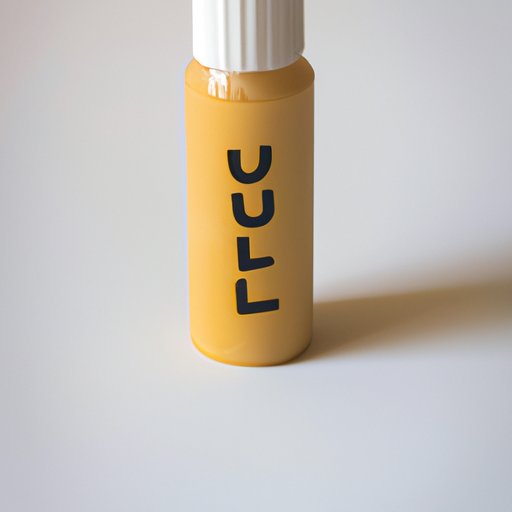
I. Introduction
Have you ever been in the middle of a project and realized you don’t have any glue? It’s frustrating to be held up by such a simple problem, but don’t worry, we’ve got you covered! In this article, we’ll provide a step-by-step guide on how to make homemade glue using natural ingredients easily. Not only will you no longer be stuck without glue, but you’ll also be saving money and avoiding harmful chemicals found in store-bought glue.
II. Step by Step Guide: How to Make Homemade Glue
Making your own glue is easier than you may think. All you need are some basic ingredients and tools, and you’re good to go! The following are simple step-by-step instructions for making your own homemade glue.
Ingredients:
- 2 tablespoons of flour
- 1/4 cup of water
- 1 tablespoon of sugar
- 1/4 teaspoon of vinegar or lemon juice
Tools:
- Bowl
- Saucepan
- Spoon
- Stove
- Container to store your glue
Instructions:
- Mix together the flour and water in a saucepan and stir well until they are combined.
- Add the sugar to the mixture and mix until dissolved.
- Put the saucepan on the stove and heat the mixture over medium heat, stirring constantly. Stop stirring once the mixture has thickened.
- Add vinegar or lemon juice to the thickened mixture and stir well.
- Remove the mixture from the heat and let it cool until it is safe to touch.
- Pour the homemade glue into a container and store in the refrigerator for up to a week.
It’s essential to follow safety procedures when making your own glue. Make sure to avoid spills and keep away from children and pets, especially when using hot glue.
III. 5 Easy DIY Glue Recipes for Crafting and Fixing
Homemade glue is not only easy to make, but it can also be much more effective for specific materials. Plus, there are different DIY glue recipes for a variety of different types of projects. Here are five easy DIY glue recipes you can use for crafting and fixing materials such as paper, wood, and fabric:
- Paper Glue: Mix one part flour with three parts water and stir until smooth.
- Woodworking Glue: Combine one cup of water and one cup of cornstarch. Heat the mixture over medium heat until it thickens, then let it cool and use as needed.
- Fabric Glue: Mix equal parts white vinegar and cornstarch until smooth. Heat the mixture until it thickens, then let it cool before use.
- Clear Glue: Combine one cup of corn syrup, one cup of white vinegar, and one tablespoon of almond extract. Mix well and store in an airtight container.
- Super Glue: Mix equal parts of baking soda and cyanoacrylate glue. Apply to the desired surface and let it dry completely.
By using homemade glue, you can not only save money but also avoid using potentially harmful chemicals found in store-bought glue.
IV. The Benefits of Making Your Own Glue and How to Do It
Making your own glue has many benefits. Not only is it cost-effective, but it’s also versatile and customizable for different materials and projects. Plus, you have the peace of mind of knowing exactly what ingredients you’re using, avoiding any toxic chemicals that may be present in store-bought glue.
Here are some tips on how to make the best use of homemade glue in different situations:
- For crafting projects: consider adding food coloring or glitter to your glue for a personalized touch.
- For fixing materials: use glue sparingly to avoid any issues with structural integrity.
- For school projects: use homemade glue to avoid exposure to potentially harmful chemicals found in store-bought glue, especially for children.
V. Eco-Friendly Glue Making: Using Natural Ingredients
Store-bought glue can be harmful to the environment, especially when they contain toxic chemicals or are disposed of improperly. Making your glue with natural ingredients at home is one way to reduce your environmental impact. Here is a list of natural ingredients that you can use to make glue at home:
- Flour
- Sugar
- Milk
- Starches (cornstarch, potato starch)
- Gelatin
- Egg whites
Using natural ingredients is also cost-effective, and it gives you more control over what goes into the glue.
VI. From Flour to Milk: Unconventional Glue Recipes to Try at Home
If you’re feeling adventurous, you can try some unconventional glue recipes using ingredients that you might not have considered before. Here are a few examples:
- Potato Starch Glue: Mix 1/2 cup potato starch with 1/2 cup water and heat until it thickens. Let it cool before using.
- Egg White Glue: Whip up two egg whites until stiff and add a pinch of salt. Use a pastry brush to apply the glue to your desired surface and let it dry.
- Gelatin Glue: Mix 1/4 cup of cold water with one envelope of unflavored gelatin and let it sit for five minutes. Add 1/4 cup of boiling water and stir until the gelatin is dissolved. Let it cool before using.
While unconventional glue recipes can be fun to try, they may not be as effective as traditional ones, especially when it comes to structural integrity.
VII. Conclusion
Homemade glue is easy to make and cost-effective, and it’s also an excellent way to reduce your environmental impact. Whether you’re crafting, fixing, or working on school projects, making your own glue is a practical and fun solution. Remember to follow safety procedures when making glue, and always use natural ingredients for a more eco-friendly approach.




